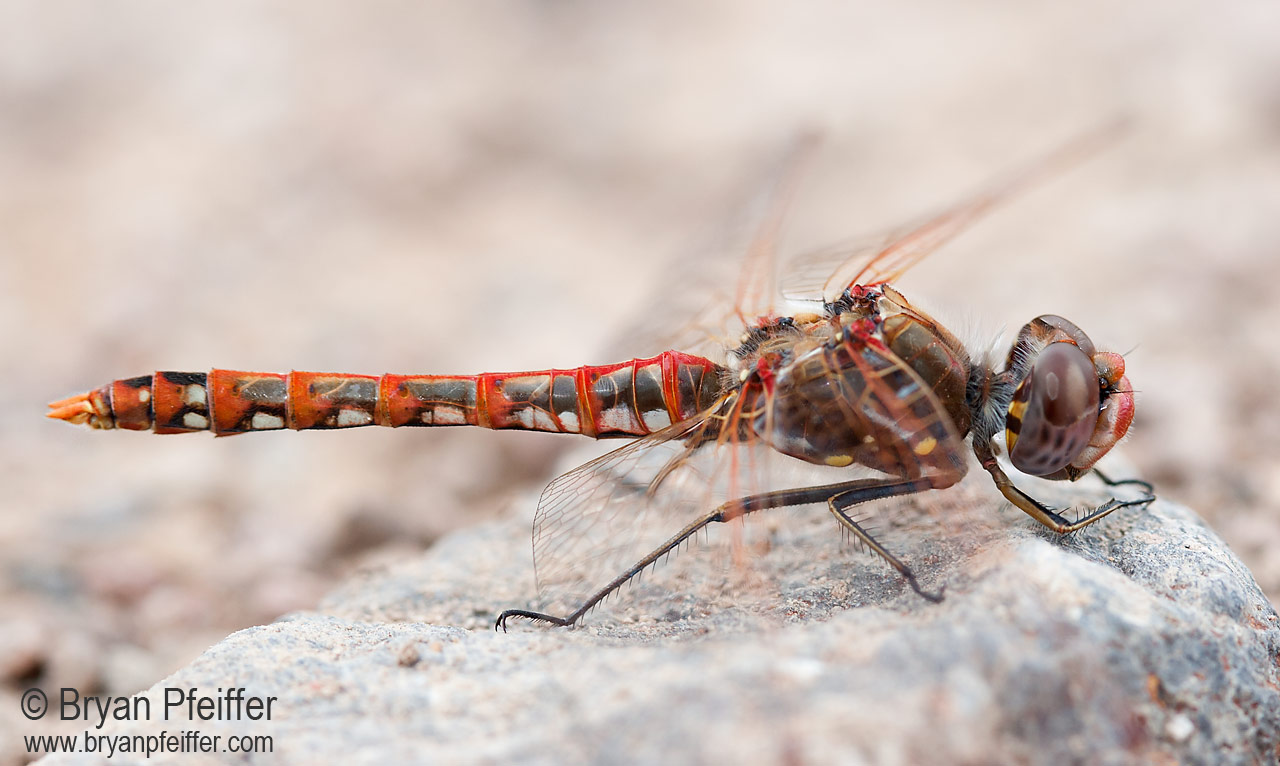What’s This? No. 21
My next What’s This? nature challenge was along the Gila River in southwestern New Mexico last week. I won’t reveal whether this is animal, vegetable, mineral or other. Name it and you could win $5 off any of my nature outings or workshops. I’ll choose a winner at random from among the correct answers (so no need to rush) submitted in the comments section below. Once the contest ends on Friday morning, I’ll list everyone who got it right.
Added January 9:
We have a winner. Actually, two winners plus our customary honorable mention for creativity. This odd pattern comes from the abdomen of a dragonfly — Variegated Meadowhawk (Sympetrum corruptum). It’s the only dragonfly I saw during my six weeks along the Gila River in southwestern New Mexico. (Hey, it snowed here in the desert the other day.)
Variegated Meadowhawk is also migrant, moving south in huge numbers in the western mountains and along the coast of the Pacific Northwest. We’re actually monitoring dragonfly migration with a project called the Migratory Dragonfly Partnership (MDP). You can help.
Another cool thing about the dragonfly is that it’s a vagrant in the east. No, not a bum, but rather a wanderer, kind of like Lark Sparrow, Dickcissel and other western or midwestern bird species that regularly turn up far east of their usual ranges. We’ve got native meadowhawks in the east, including this pair of White-faced Meadowhawks that are together, um, er, well, you know — making more White-faced Meadowhawks.
Now the winners — in three categories:
People Who Notoriously Know and Love Dragonflies
Celeste Mazzacano was first among these folks to submit the correct answer. She initially wrote: “Sympetrum corruption.” Then “Damn autocorrect – corruptum.” Celeste runs the MDP, so she knows her corruptums from corruption.
Randomly Selected Correct Answer
Freda van den Broek. Way to go, Freda!
Honorable Mention for Creativity
Sara Backer, who writes:
“I don’t know the Latin name, but this is a portion of the carapace of what Pueblos called the “tooth turtle.” Legend says Coyote got in trouble flirting with a shaman’s wife and the shaman retaliated with an overly-aggressive dental procedure. Coyote’s teeth and blood fell on the turtle’s back and became a reminder to move slowly and carefully around other men’s wives.”
- “Cave painting/petroglyph of an eagle”
- “tail of a scorpion?”
- “It looks like porcelain”
- “This is what surgeons call GOK (for God Only Knows). Butterfly wing? Fish scales? Native American featherwork? Oarlocks on a river raft? Love these quizzes. No idea.”
- “New Mexico Milk Snake”
I do like that Milk Snake answer. That would be Lampropeltis triangulum celaenops, also known as King Snake, with a similar black-red-white/yellow pattern. (Note also that Jim Johnson comically made the snake connection when he correctly named the dragonfly.) Milk/King Snake is a mimic of the seriously venomous Coral Snake. Remember: Red on black, venom lack. Red on yellow, kill a fellow. So you’re okay with that one above.
Find my 20 previous What’s This? challenges here.
[For more good stuff like this, sign up for my email newsletter Natural Selections, which features occasional news from the frontiers of wildlife science and from my own adventures in wild places.]




It’s a horizontal shot of the right side of the abdomen of a mature male Variegated Meadowhawk (Sympetrum corruptum).
I think it’s the abdomen of a Variegated Meadowhawk dragonfly (Sympetrum corruptum).
Sympetrum corruptum
My guess is that its a section of the abdomen (possibly dorsal surface) of a Variegated Meadowhawk male.
Well, since no one else has commented I’ll take a shot. Variegated Meadowhawk.
It’s either a snake or a Sympetrum (Tarnetrum) corruptum…
I don’t know the Latin name, but this is a portion of the carapace of what Pueblos called the “tooth turtle.” Legend says Coyote got in trouble flirting with a shaman’s wife and the shaman retaliated with an overly-aggressive dental procedure. Coyote’s teeth and blood fell on the turtle’s back and became a reminder to move slowly and carefully around other men’s wives.
Let’s try Variegated Meadowhawk
Damn autocorrect- corruptum!
ABdomen of Sympetrum corruption